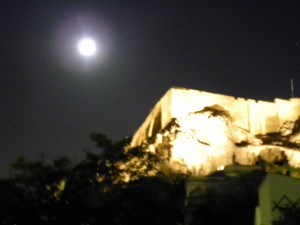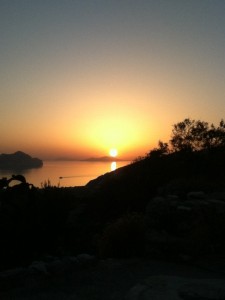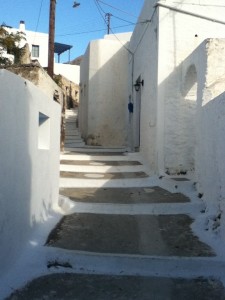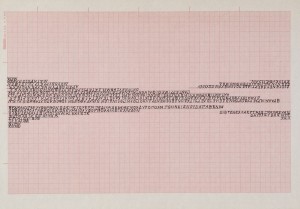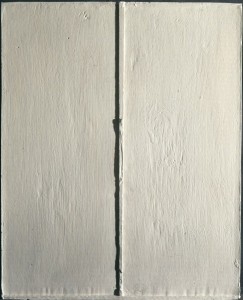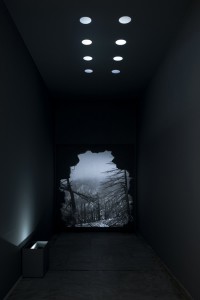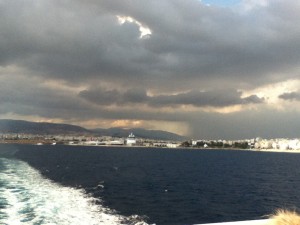Sonic Time: Speech Sound Silence at the National Museum of Contemporary Art in Athens
While the protests were raging in the streets in Athens, the National Museum of Contemporary Art was holding a retrospective from its permanent collection of cerebral conceptual art since the late 1960s. It was beautifully curated by Ana Kafetsi.( you can see all the images on the website, as well as detailed explanations. Ypu can see more of my Cycladic pictures on Art and Politics Now Flikr site)
Since I arrived in Athens after the protests ended (all I saw was a Susan Komen race for the cure), and I had just spent 10 days on a remote Greek Island, I decided it was time for an injection of contemporary art.
At first I thought oh dear how can I possibly be interested in this, but then I surrendered to the John Cage work, lay on the floor for 30 minutes of blissful emptiness listening to his extraordinary composition and watching light and dark patterns changing in the room, and I left with a new feeling of receptiveness to conceptual art. The 1992 Cage piece is very long, a total of 94 minutes, I heard just a part. Opus One 11 is a “Film without subject.” Of 103, Cage writes: “103 is an orchestral work. It is divided into seventeen parts. The lengths of the seventeen parts are the same for all the strings and the percussion. The woodwinds and the brass follow another plan… Following chance operations, the number of wind instruments changes for each of the seventeen parts.” At any rate it was beautiful in its randomness with an underlying sense of classicism.
After observing sunrises and sunsets, experiencing the burning midday sun and the rapid descent of darkness in Greece, I was really tuned into light and random experiences. Light is really what Greece is about in an aesthetic sense and random is what life is like if we give it a chance.
So then I went back to three early works, Sol Le Witt’s Sentences on Conceptual Art( 1969), John Baldessari singing Le Witt’s sentences to popular tunes ( 1972), and Lawrence Weiner’s Declaration of Intent from 1969. Le Witt’s sentences are still resonant today and many artists would benefit from thinking about them. So here are these three “old masters” of conceptual art in the Greek National Museum, as protests against austerity rage in the country.
Let us think about that. For example, these artists were fed up with capitalism, they were looking for the underlying structure and purpose of art outside the physical aesthetic object. The protesters are also fed up with capitalism and its dictates. They want the underlying significance of the state to survive, that is the obvious idea that the government is meant to provide certain basic supports for its citizens ( of course in the US that idea has been entirely thrown out- the government here is intended to be privatized). What the conceptual artists and the Greek protesters share is disgust with the corruption of capitalism and its corrosive effect on the spirit.
In his 1969 work. Weiner is really young, bearded, lanky. He is wading into a storm tossed sea to get random pieces of driftwood ( drift logs I should say) that can or cannot be made into a sculpture if desired. It is a lovely open ended statement – “I don’t care about the thing, I care about the act and the act is determined by wind, sea, rain, water, and my own strength or ingenuity in lifting these logs.” ( that is a pseudo quote)
Gary Hill was well represented in the exhibition with many many pieces, a virtual mini retrospective of Gary Hill. One of the most intriguing was a piece called Thomas the Obsucre based on a book of that name from 1987, in which Hill is telling a story ( sort of). Looking at this piece, it was easy to see why he gave up on that direction and turned to the components of video, light, movement, space, sound, and psychological experiences.
The exhibition included many major Greek contemporary artists, for example, there was Bia Davou, with tiny drawings with Greek letters on graph paper called Serial Structures:Odyssey,
and Chryssa with an amazing Cycladic book from 1957.
Having just come from the Cyclades, it was easy to connect to this all white piece. There were other less well known Greek artists, that I enjoyed seeing, particularly the 2012 sound and video installation with a surprise ending by Makis Faros that suggests a collapse of expectations.
The intersections of Greek art and historical conceptual art was revealing,- sound and light are both basic components of the Greek environment. and naturally of Greek art.
The high point of the show for me was the accidental overlap and juxtaposition of two pieces. The first was by Bruce Nauman, Playing a Note on a Violin While I walk Around the Studio, from 1967 – 68.
Right next to his piece (so close that his violin could be heard) was another piece by Danae Statou called Ice Songs 2. These were the sounds of icebergs in the Antarctic forming, colliding, squeezing together, going into the open sea. The source of the sounds was a result of scientists monitoring the break up of Antarctica with water microphones on the sea bed of a defunct US naval base They were formerly part of a massive monitoring effect to track Soviet submarines. She collaborated with Vassilis Koutouris on imagery to accompany the sounds. Changing waves of blue and white projected on the floor of a large gallery floor provided accents to the changing sounds of the ice bergs. So here was juxtaposed a violin note ( actually two close together) by an artist rejecting aesthetics and consumption, and an accidental sound “concert” by ice bergs cracking up (of course related to our warming planet).
But in contrast to the 1960s artists who offered an escape from the clutter and corruption of the world, this piece is calling attention to the disintegration of the world. The piece intentionally has meaning beyond the sound itself. It is telling us of the invisibile and powerful forces at work all the time.
If we don’t actually pay attention to these particular random sounds and what they signify, we are looking at an end of the world, a forecast of which we had this week with the Super Storm Sandy, itself a coming together of various powerful forces and fronts. Global climate change is with us. The extraordinary power of nature is going to win the day in the end. That is getting more evident every day. The conceptualist artists definitely had the right idea about rejecting capitalism and the “art” world and embracing nature on its own terms.
This entry was posted on October 31, 2012 and is filed under Contemporary Art.

